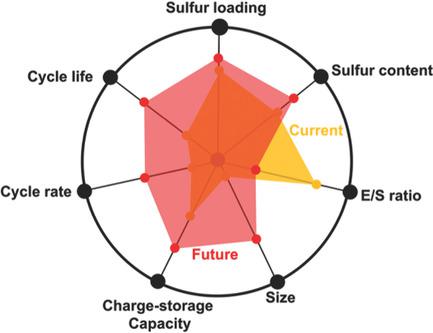当前位置:
X-MOL 学术
›
Adv. Funct. Mater.
›
论文详情
Our official English website, www.x-mol.net, welcomes your
feedback! (Note: you will need to create a separate account there.)
Progress on the Critical Parameters for Lithium–Sulfur Batteries to be Practically Viable
Advanced Functional Materials ( IF 18.5 ) Pub Date : 2018-05-29 , DOI: 10.1002/adfm.201801188 Sheng-Heng Chung 1 , Chi-Hao Chang 1 , Arumugam Manthiram 1
Advanced Functional Materials ( IF 18.5 ) Pub Date : 2018-05-29 , DOI: 10.1002/adfm.201801188 Sheng-Heng Chung 1 , Chi-Hao Chang 1 , Arumugam Manthiram 1
Affiliation

|
Lithium–sulfur batteries have great potential to satisfy the increasing demand of energy storage systems for portable devices, electric vehicles, and grid storage because of their extremely high specific capacity, cost‐effectiveness, and environmental friendliness. In spite of all these merits, the practical utilization of lithium–sulfur batteries is impeded by commonly known challenges, such as low sulfur utilization (<80%), short life (<200 cycles), fast capacity fade, and severe self‐discharge effect, which mainly result from the i) low conductivity of the active material, ii) serious polysulfide shuttling, iii) large volume changes, and iv) lithium–metal anode contamination/corrosion. Numerous approaches are reported to effectively mitigate these issues. Indeed, such approaches have shown enhanced lithium–sulfur battery performances. However, many reports overlook the critical parameters, including sulfur loading (<13 mg cm−2), sulfur content (<70 wt%), and electrolyte/sulfur ratio (>11 µL mg−1), that significantly affect the analyzed electrochemical characteristics, energy density, and practicality of lithium–sulfur batteries. This review highlights the trends and progress in making cells fulfilling these fabrication parameters and discuss the challenges of the amount of sulfur and electrolyte in fabricating cells with practically necessary parameters and with high electrochemical utilization and efficiency.
中文翻译:

锂硫电池实际可行的关键参数研究进展
锂硫电池具有极高的比容量,成本效益和环境友好性,因此有潜力满足便携式设备,电动汽车和电网存储对能量存储系统不断增长的需求。尽管有所有这些优点,但锂硫电池的实际使用仍然受到众所周知的挑战的困扰,例如低硫利用率(<80%),寿命短(<200个循环),快速的容量衰减和严重的自放电这种影响主要是由于以下原因造成的:i)活性材料的电导率低,ii)严重的多硫化物穿梭,iii)体积变化大,iv)锂金属阳极污染/腐蚀。据报道,有许多方法可以有效地缓解这些问题。确实,此类方法显示出增强的锂硫电池性能。-2),硫含量(<70 wt%)和电解质/硫比(> 11 µL mg -1),这对分析的锂硫电池的电化学特性,能量密度和实用性有重大影响。这篇综述重点介绍了使电池满足这些制造参数的趋势和进展,并讨论了在制造具有实际必要参数且具有高电化学利用率和效率的电池中硫和电解质的数量所面临的挑战。
更新日期:2018-05-29
中文翻译:

锂硫电池实际可行的关键参数研究进展
锂硫电池具有极高的比容量,成本效益和环境友好性,因此有潜力满足便携式设备,电动汽车和电网存储对能量存储系统不断增长的需求。尽管有所有这些优点,但锂硫电池的实际使用仍然受到众所周知的挑战的困扰,例如低硫利用率(<80%),寿命短(<200个循环),快速的容量衰减和严重的自放电这种影响主要是由于以下原因造成的:i)活性材料的电导率低,ii)严重的多硫化物穿梭,iii)体积变化大,iv)锂金属阳极污染/腐蚀。据报道,有许多方法可以有效地缓解这些问题。确实,此类方法显示出增强的锂硫电池性能。-2),硫含量(<70 wt%)和电解质/硫比(> 11 µL mg -1),这对分析的锂硫电池的电化学特性,能量密度和实用性有重大影响。这篇综述重点介绍了使电池满足这些制造参数的趋势和进展,并讨论了在制造具有实际必要参数且具有高电化学利用率和效率的电池中硫和电解质的数量所面临的挑战。











































 京公网安备 11010802027423号
京公网安备 11010802027423号